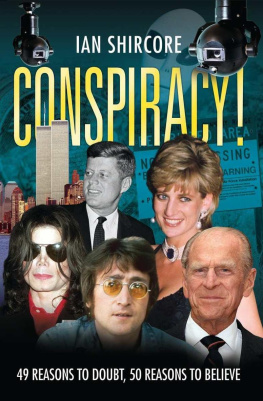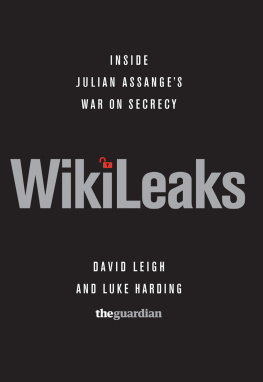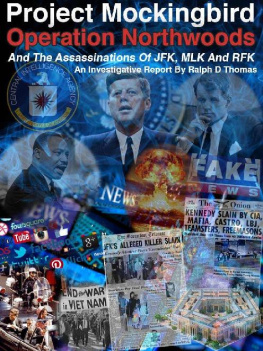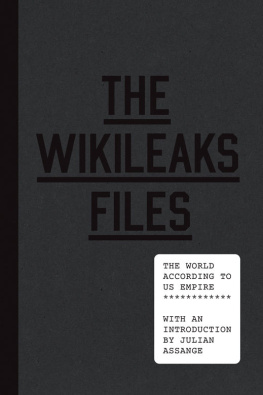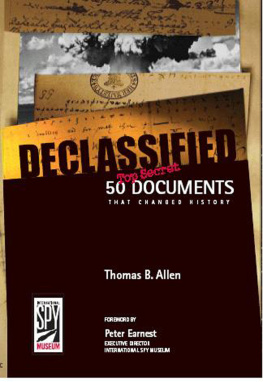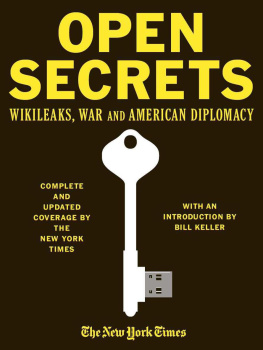This is for all the whistleblowers, leakers and freedom of information activists who have helped demystify the world around us.
ACKNOWLEDGEMENTS
T his books ability to find new perspectives on so many old stories is a tribute to the awesome power of technologies like the internet and DNA profiling. It is also a tribute to the genuine efforts of people, courts and some governments to let light into dark corners.
Specifically, I would like to thank all those awkward individuals whose freedom of information requests have unearthed so much new evidence, the anonymous footsoldiers of the WikiLeaks revolution and the enlightened organisations, like Americas independent National Security Archive, that have made thousands of declassified documents available to all online.
CONTENTS
INTRODUCTION
YESTERDAYS SECRETS MAKE TODAYS NEWS
O nce you know about Operation Northwoods, youll never be quite sure whether the Kennedy assassinations were the tip of the iceberg.
Once youve seen what WikiLeaks has revealed about the radioactive poisoning of Alexander Litvinenko, you wont be so sure about the British secret services.
Once youve weighed the evidence yourself, you may well decide that there was a second Yorkshire Ripper, that cricketing hero Bob Woolmer was murdered and that rock icon Jim Morrisons death in Paris was anything but straightforward.
Suddenly, leaked cables and declassified papers are rewriting history. Did Lech Walesa spy for the Polish version of the KGB? Did British scientists spray chemical and biological warfare agents from aircraft over Swindon, Norwich and Southampton? And was a Conservative government minister conspiring with the police and the Primate of All Ireland to hide a Catholic priests involvement in one of the worst bombings of Irelands troubles?
WHOSE SIDE ARE THEY ON?
Conspiracies real and imagined have shaped the world we live in. MI5, MI6, the hyperactive CIA and the coolly efficient Mossad, the bloodstained KGB and its orphan child, the FSB, have all pushed and pulled the destinies of rulers and nations. So have fakers and manipulators, business moguls, politicians and gangsters.
Millions of people honestly believe that 9/11 was a false flag operation, a cruel, staged attack on Americans by the American government, aimed at justifying George Bushs War on Terror. Many in Britain think the loose ends and inconsistencies around the London 7/7 bombings are signs that they were not what they seemed.
Such brutal cynicism ought to be unthinkable. But when you know that Americas top generals, the Joint Chiefs of Staff, signed off a plan to stage bomb blasts and shootings on the streets of Washington and Miami as an excuse for attacking Cuba, the unthinkable cannot be ruled out. That plan was Operation Northwoods and it went right to the top before JFK and his defence secretary vetoed it.
Would a UK government agency drip sarin nerve poison on to the skin of young volunteers after telling them it was researching a cure for the common cold? It would. It did. And it killed at least one of them in less than an hour, though it took 50 years to admit it.
Were the deaths of the Polish president and 95 other VIPs in the Smolensk air disaster in 2010 just the result of pilot error? Did weapons expert David Kelly really commit suicide after leaking information about the build-up to the Iraq War? Is there something more than posturing behind rap musics deadly obsession with Illuminati symbols and messages? Who was responsible for the crash that killed Princess Diana? And why do pilots still shudder at the thought of TWA Flight 800, the jumbo jet that exploded off Long Island with 230 people on board?
SOME NEW ANSWERS, MANY MORE QUESTIONS
Just glancing through the first ten conspiracy cases examined in this book, you can see many of the key themes emerging. Ghastly crimes, sneaky cover-ups and botched investigations provide most of the 50 chapters, with a lot of political manipulation and secret service skulduggery in the background.
But this is not meant to be a dull reference book, so bunching the assassinations together or having one section dedicated to air crashes and another to CIA plots didnt seem right. In the end, the running order has been chosen with an eye to pacing and readability, with surprise as the key ingredient. If you are not being shocked or surprised every couple of pages, this book is not doing its job.
Bug-eyed monsters, rampant paranoia and Elvis lives stories have given conspiracy theories a bad name. When youve got wild-eyed obsessives who believe everythings a conspiracy versus sneering Establishment figures who insist that nothing is, the argument is never going to get far. But an idea is not responsible for the people who believe in it and there really are a lot of legitimate, unanswered questions in this area. The newest evidence available today, via WikiLeaks, declassified internet archives and freedom of information requests in the UK and America, shows that a surprising number of them need to be looked at with fresh eyes.
DAVID KELLY
FAR TOO MANY
UNANSWERED QUESTIONS
A s the helicopter slowly clattered its way through the darkness, the crewmen knew what they were looking out for in the fields and woods below them.
Criss-crossing the Oxfordshire night in a tight search pattern, they were looking for a man or a body.
The UKs leading chemical and biological warfare expert, Mr Anthrax himself, the top specialist from the secretive Porton Down laboratories, had gone missing. But if he had had an accident or worse in the countryside down there, they would find him. The helicopter had modern thermal imaging search and rescue equipment. In skilled hands, that doesnt miss much.
Dr David Kelly was a former UN weapons inspector in Iraq, a veteran of 37 rounds of that high stakes cat-and-mouse game. He had been accused of leaking information to the BBC that cast doubt on the British governments reasons for invading Iraq. He knew about the famous sexed-up dossier that claimed Saddam Hussein had weapons of mass destruction (WMDs) that could be used at 45 minutes notice and he had indicated to BBC reporter Andrew Gilligan that this key claim was simply not true.
As a result, two days earlier, on 15 July 2003, he had been called before Parliaments Select Committee on Foreign Affairs for a very uncomfortable televised public grilling, followed by a private session with the British intelligence services at a safe house outside London.
Dr Kelly was in the spotlight and under intense scrutiny as his wife, Janice, said, a distressed man.
But that doesnt mean that he killed himself. When he went out for his usual afternoon walk on nearby Harrowdown Hill, round about three on the afternoon of Thursday, 17 July 2003, nothing seemed out of the ordinary. He had been working in his study all morning even arranging to fly to Iraq a week later, on 25 July and had arranged to meet his daughter, Rachel, that evening, so the day was unfolding in a fairly routine way. Curiously, despite the intense media interest, the pressmen who had been doorstepping the house had gone.
It was only when he hadnt come home much later after midnight that Janice Kelly called the police. Recognising that he was a man under pressure, they began a search that included putting up the police helicopter.
According to the search pattern the pilot was flying, it must have been nearly three oclock in the morning when the helicopter, with its heat-seeking search equipment, flew over the edge of the woods on Harrowdown Hill. The crew saw nothing to report.

